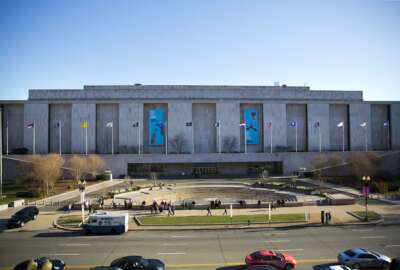
Smithsonian worried about climate change impact on buildings, artifact storage
Smithsonian Institution staff told lawmakers Thursday of the need to account for extreme weather events in building maintenance and future capital projects.
Only about 2% of the Smithsonian’s approximately 155 million artifacts are on display at any given time. The rest are in storage facilities including in the basements of the Smithsonian’s 11 museums and galleries around the National Mall.
That leaves them susceptible to flooding from the nearby Tidal Basin and Potomac River, but climate change threatens federal assets around the globe, not just in the U.S. Institution staff told lawmakers Thursday of the need to account for extreme weather events in building maintenance and future capital projects.
“The Smithsonian recently completed and published the 2021 Climate Change Action Plan in line with the principles established in Executive Order 14008 [“Tackling the Climate Crisis at Home and Abroad”]. Focusing on the priority areas of public programs, research, collections, management, and facilities and infrastructure, the document also gives special focus to the topic of climate vulnerability,” Facilities Director Nancy Bechtol told the House Administration committee. “Because the Smithsonian is such a multi-faceted organization, these topics and action items are not siloed, but instead are shared One-Smithsonian responsibilities.”
The institution is also part of an interagency team of federal, District of Columbia, regional and academic experts, known as the DC Silver Jackets, to study flood mitigation options for the National Capital Region. The Silver Jackets, which includes the U.S. Army Corps of Engineers, are assessing the cost and benefits of a pumping station to redirect excess water away from the National Mall and to the Potomac River, which Bechtol said, “would be expensive and would require interagency cooperation and management.”
Further out in the D.C. suburbs, the Smithsonian intends to expand its collection of storage facilities in Dulles, Northern Virginia, and Suitland, Maryland. As part of a 40-year master plan for those sites, construction is set to start in fiscal year 2022 on a sustainable facility at the Suitland Collections Center to store collections now housed in flood-prone basements on the Mall. The master plan recommends sustainable building practices including high-performance, well-insulated buildings, photovoltaic roofs, and geothermal energy generation for enhanced resiliency against weather-related outages and climate change.
That facility, whose buildings date to the 1950s and 1960s, contain hazardous chemicals. One even collapsed from snow in 2010, which was followed by damage from the 2011 earthquake, according to the Smithsonian’s Office of the Inspector General.
The Dulles Collections Center Master Plan also includes collection facilities for the planned American Latino and the Smithsonian American Women’s History Museums, which Congress authorized last year and which many hope will be built on or near the Mall. When Committee Ranking Member Rodney Davis asked about the additional flood risk this could pose, Bechtol said the Smithsonian is considering 24 locations for those museums, two of which do come with such risks.
One factor hampering the Institution’s ability to weatherize its facilities is the growing backlog of deferred maintenance projects, which is now worth over $1 billion. Smithsonian Inspector General Cathy Helm told the committee that a 2016 audit revealed the Institution was spending less than the recommended amounts to maintain the condition of its facilities. Bechtol said they set aside about 1% of their annual budget for deferred maintenance, even though the industry average for museums and cultural institutions is between 2%-4%. She said that appropriations of $35 million in both FY 2020 and FY 2021 went to the backlog, and that nearly half of the backlog is addressed in the Revitalization of the Historic Core project and the National Air and Space Museum Revitalization project, which are underway.
Meanwhile, the new 2021 Climate Change Action Plan, which the OIG has yet to evaluate, includes steps for greater facility climate resiliency, and it recommends disclosing climate vulnerability in the Smithsonian’s financial reporting and enterprise risk management process.
“Incremental progress on individual building resilience [around National Mall] is achievable within current funding levels but may not keep pace with increasing climate change impacts,” the plan says.
It also warns that leased buildings do not offer the same resiliency as Smithsonian-owned sites built to current standards. The plan said if a major climate disaster hits, that could reduce the market for leased space even further.
The plan also includes workforce measures to reduce climate risks. The Smithsonian’s Chief Sustainability Officer will lead climate literacy enhancement efforts for the Institution’s management workforce, and Bechtol said they are training facilities staff to respond to weather emergencies, which can often happen after regular business hours.
“We have established, starting in 2016, a training program that for preparedness and response in collections emergencies, and we have stood up an SI-wide team of professionals that actually would come in to any type of emergency, would come in to respond,” she said. “That team is made up of our security workforce, our maintenance workforce, our operations cleaning workforce, as well as those collections managers.”
Lawmakers asked about the reliability of using the FEMA floodplain maps to assess risk levels at federal sites. The maps have designations of probability of flooding in a given time period, and were originally intended for use by the National Flood Insurance Program. Any place with a 1% or higher chance of experiencing a flood each year is considered to have a high risk by FEMA, but changing storm behaviors and the increase of historical data each year mean those maps are constantly being redrawn to better reflect likelihood.
Phetmano Phannavong, senior project manager for engineering, design and planning company Atkins North America, told the committee that going forward agencies need to incorporate more measures for building flood-resilient infrastructure in the “new reality.”
“We need to start to take that science down to the engineering level and planning level. What would it look like in different scenarios, so that we can plan for it,” he said. “The technology and science [are] there, I think we just need policies and the way that we design and construct things to meet that new challenge.”
Copyright © 2025 Federal News Network. All rights reserved. This website is not intended for users located within the European Economic Area.
Amelia Brust is a digital editor at Federal News Network.
Follow @abrustWFED




